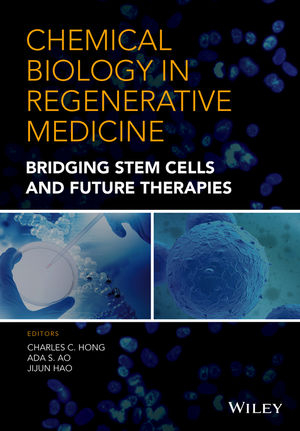
Chemical Biology in Regenerative Medicine
John Wiley & Sons Inc (Verlag)
978-1-118-34959-5 (ISBN)
- Titel z.Zt. nicht lieferbar
- Versandkostenfrei innerhalb Deutschlands
- Auch auf Rechnung
- Verfügbarkeit in der Filiale vor Ort prüfen
- Artikel merken
Chemical Biology in Regenerative Medicine: Bridging Stem Cells and Future Therapies
The field of regenerative medicine has advanced at a rapid pace and this comprehensive summary of new developments is a timely contribution to the field as clinical trials have begun to assess the safety and efficacy of cell-based therapies.
In Chemical Biology in Regenerative Medicine, an international team of experts provides an overview of progress towards clinical application in the areas of transplantation (allogenic and autologous), manipulation of niche environment and homing, and cell reprogramming (trans-differentiation and de-differentiation). The book highlights the interdisciplinary approaches undertaken to resolve current technical problems in regenerative medicine, with special attention paid to small molecules and biomaterials engineering.
This volume provides an essential overview of this emerging technology for researchers in academic, industrial and clinical environments working in regenerative medicine, chemical biology, biochemistry, cell biology, biomaterials and bioengineering. It is appropriate for training students and newcomers to the field, benefitting readers in broadening their knowledge and giving them insights to regenerative chemical biology, as well as encouraging readers to implement the key points in their own fields of study to develop new technologies.
Dr Charles C. Hong is a physician-scientist with background in molecular biology, developmental biology, chemical biology, and cardiovascular genetics. He is an Associate Professor of Cardiovascular Medicine, Pharmacology, and Cell and Developmental Biology, and a member of the Veterans Affairs Tennessee Valley Healthcare System.? He is also a member of the Vanderbilt Institute of Chemical Biology and the Vanderbilt Center for Stem Cell Biology.?Dr. Hong received his MD-PhD with Honors from Yale, then completed cardiology fellowship at Massachusetts General Hospital, where he was a Schreyer Fellow, and postdoctoral fellowship at Harvard Medical School, where he was a Sarnoff Scholar. After a brief stint on the Harvard Medical School faculty, Dr. Hong came to Vanderbilt in 2006.?The Hong laboratory is focused on Chemical Biology of vertebrate development and stem cell differentiation, specifically Chemical Genetics of Embryonic Development; Regenerative Chemical Biology & Drug Discovery/ Experimental Therapeutics. Dr Ada S. Ao, Postdoctoral Research Fellow, Department of Medicine, Division of Cardiovascular Medicine, Vanderbilt University, USA. Prof Jijun Hao, Research Assistant Professor, Western University of Health Sciences, USA.
List of Contributors xi Preface xiii
1 Wnt Signaling in Regulation of Stem Cells 1
David T. Paik and Antonis K. Hatzopoulos
1.1 Overview of Wnt Signaling 1
1.2 Wnt Signaling in Embryonic Stem Cells 2
1.3 Wnt Signaling in Cardiovascular Progenitor Cells and Cardiomyocyte Differentiation 3
1.4 Wnt Signaling in Mesenchymal Stem Cells 5
1.5 Wnt Signaling in Hematopoiesis and Hematopoietic Stem Cells 7
1.6 Wnt Signaling in Neural Stem Cells 8
1.7 Wnt Signaling in Endothelial–Mesenchymal Transition 8
1.8 Conclusion 9
References 10
2 Directed Cardiomyogenesis of Pluripotent Stem Cells 15
Jeffery B. Bylund and Antonis K. Hatzopoulos
2.1 Introduction 15
2.2 A Brief Review of Heart Development 16
2.2.1 Cellular and Morphological Movements 16
2.2.2 Molecular Events in Heart Development 19
2.2.2.1 Molecular Events of Mesoderm Derivation 19
2.2.2.2 Transcription Factors in Cardiac Development 20
2.2.2.3 Major Developmental Signaling Pathways in Cardiac Development 22
2.3 Introduction to Pluripotent Stem Cells 23
2.3.1 Unique Features of Pluripotent Stem Cells 23
2.3.2 Pluripotent Stem Cell Sources 24
2.3.3 Maintaining Pluripotency 24
2.4 Cardiomyocyte Differentiation 25
2.4.1 Inducing Differentiation 25
2.4.2 Directed Cardiomyogenesis 26
2.5 Conclusion 28
References 29
3 Chemical Genetics in Cardiomyocyte Generation 35
Daqing Jin, Qiao Li, and Tao P. Zhong
3.1 Introduction 35
3.2 iPSC Generation 36
3.3 The Chemical Genetics Approach in iPSC Generation 37
3.4 Heart Regeneration 40
3.5 The Chemical Genetics Approach in Heart Regeneration 42
3.6 Cardiac Cell Transdifferentiation 43
3.7 Conclusion 44
Acknowledgements 44
References 44
4 Challenges and New Directions for Cardiac Reprogramming 49
Young-Jae Nam and Nikhil Munshi
4.1 Introduction 49
4.2 Strategies for Heart Repair 49
4.3 Direct Reprogramming Approaches 50
4.4 Current Challenges 53
4.5 Conclusion 56
Acknowledgements 56
References 56
5 Comparative Analysis of Adult Stem Cell Niches 59
Bryan A. Fioret and Antonis K. Hatzopoulos
5.1 Adult Stem Cells 59
5.2 Adult Stem Cell Niches 60
5.3 The Hair Follicle Stem Cell (HFSC) Niche 61
5.4 The Intestinal Stem Cell (ISC) Niche 63
5.5 The Hematopoietic Stem Cell (HSC) Niche 66
5.5.1 Endosteal Niche 66
5.5.2 Vascular Niche 67
5.5.3 Progeny “Niche” 68
5.6 The Neural Stem Cell (NSC) Niche 68
5.6.1 V-SVZ Niche 69
5.6.2 SGZ Niche 70
5.7 A Comparison between Tissue-Specific Adult Stem Cell Niches 71
5.8 Future Challenges 73
Acknowledgements 73
References 73
6 Chemicals and Stem Cells in the Promotion of Regeneration 77
Dikshya Bastakoty, Sarika Saraswati, and Pampee P. Young
6.1 Introduction 77
6.2 Biologics in Regenerative Medicine 78
6.2.1 Growth Factors and Pro-Angiogenic Agents 78
6.2.2 Immune-Modulatory Therapies 79
6.2.3 Extracellular Matrix-Based Approaches 79
6.3 Chemicals and Biomaterials for Healing 79
6.3.1 Small Molecules 80
6.3.2 Biomaterial Scaffold and Sustained Delivery 81
6.4 Stem-Cell Therapy 81
6.4.1 Chemical Manipulation of Stem Cells in Regeneration 82
6.4.2 Embryonic Stem Cells (ESCs) 82
6.4.2.1 Small Molecules for the Culture and Maintenance of ESCs 82
6.4.2.2 Small Molecules for ESC Differentiation 83
6.4.3 Induced Pluripotent Stem Cells (iPSCs) 84
6.4.3.1 Generation of iPSCs 84
6.4.3.2 Small Molecules that Affect iPSC Epigenomes 84
6.4.3.3 Small Molecules that Affect iPSC Signaling Pathways 84
6.4.4 Mesenchymal Stem Cells (MSCs) 85
6.4.4.1 Properties of MSCs 85
6.4.4.2 Small Molecules that affect MSC Differentiation 85
6.4.4.3 Biopolymers that affect MSC Biology 86
6.4.5 Hematopoietic Stem Cells (HSCs) 86
6.5 Conclusion 87
References 88
7 Chemically Induced Pluripotent Stem Cells (CiPSCs): A Potential Chemical Biological Breakthrough in Reprogramming? 95
Calvin C. Sheng, Jijun Hao, and Charles C. Hong
7.1 Searching for the “Perfect” Platform 95
7.2 Defining the Advantages of Small Molecules in Reprogramming 96
7.3 Understanding the Disadvantages of Using Small Molecules 97
7.4 Breakthrough: The CiPSC Paradigm 97
7.5 Conclusion 101
References 101
8 An Introduction to Cellular Reprogramming: The Plasticity of Cell Fates and Identities 103
Kelly P. Smith, Maria Borowski, and Joseph C. Laning
8.1 Defining Cell Potency 104
8.2 Types of Pluripotent Cell 105
8.2.1 Isolated Cell Types 105
8.2.1.1 Embryonal Carcinoma Cells 105
8.2.1.2 Embryonic Stem Cells 105
8.2.1.3 Embryonic Germ Cells 105
8.2.2 Reprogrammed Cell Types 106
8.2.2.1 Cell-Fusion Hybrids 106
8.2.2.2 Somatic Cell Nuclear Transfer Cells 106
8.2.2.3 Induced Pluripotent Stem Cells 106
8.3 Defining Pluripotency 107
8.4 The Molecular Basis of Pluripotency 108
8.5 Cellular Reprogramming: Altering the Epigenetic State 110
8.6 Cellular Reprogramming: Primary Regulatory Pathways 111
8.6.1 Temporal and Stoichiometric Considerations 113
8.6.2 Target Cell Type 113
8.7 Reprogramming Methods 114
8.7.1 Viral-Driven 114
8.7.2 Nucleic Acid/Episomal-Driven 115
8.7.3 mRNA-Driven 117
8.7.4 miRNA-Driven 117
8.7.5 Protein-Driven 118
8.7.6 External Factors/Enhancers 118
8.7.7 Direct Reprogramming 120
8.8 Applications and Future Trends 121
8.8.1 Moving Toward Clinical Applications for Cellular Reprogramming 121
8.8.2 The Merging of Stem Cells and New Methods of Genetic Engineering 125
8.8.3 Efficiency, Expense, and Safety 125
8.8.4 Developing Standards 126
8.9 Conclusion 127
References 127
9 Chemicals Facilitating Reprogramming 141
Zhong-Dong Shi, Federico Gonz´alez, and Danwei Huangfu
9.1 Introduction 141
9.2 Chemicals Modulating Epigenetic Barriers 145
9.2.1 Histone Deacetylase Inhibitors 146
9.2.2 Histone Methyltransferase Inhibitor and Demethylase Inhibitor 147
9.2.3 DNA Methyltransferase Inhibitors 149
9.3 Chemicals Targeting Signaling Pathways 150
9.3.1 TGFβ Signaling Inhibitors 150
9.3.2 Wnt Signaling and GSK3 Inhibitors 151
9.3.3 Other Kinase Inhibitors and Activators 152
9.3.4 Cell Senescence Alleviators 153
9.4 Chemicals Promoting Lineage Reprogramming 154
9.5 Conclusion 155
References 156
10 Chemicals Facilitating Reprogramming: Targeting the SAM Binding Site to Identify Novel Methyltransferase Inhibitors 163
Jeong-Do Kim, Jong S. Rim, Robert B. Crochet, Yong-Hwan Lee, Jaroslaw Staszkiewicz, Ru Gao, and Kenneth J. Eilertsen
10.1 Introduction 163
10.2 DNA Methyltransferases, Inhibition, and Reprogramming 164
10.3 DNMT Inhibitors 164
10.4 Histone Methyltransferases, Inhibition, and Reprogramming 167
10.5 Inhibitors of Lysine Methyltransferases 168
10.6 Identification of DNMT1 Inhibitor Candidates Using Virtual Screening 169
10.6.1 Functional Screening Using a DNMT1 Activity Assay 169
10.7 Targeting the SAM Binding Site to Identify Novel HMT Inhibitors 171
10.7.1 SAM Competitive Assay 173
10.7.2 SAM Binding Site is Unique and Selective across Multiple Epigenetic Targets 173
10.8 Conclusion 177
References 177
11 Biomaterials for Directed Differentiation 181
Xintong Wang, Angela L. Zachman, Simon Maltais, and Hak-Joon Sung
11.1 Introduction 182
11.2 Natural Biomaterials 183
11.2.1 ECM-Derived Materials 183
11.2.1.1 Matrigel 183
11.2.1.2 Fibrin 184
11.2.1.3 Collagen 185
11.2.1.4 Laminin 187
11.2.2 Non-ECM-Derived Materials 188
11.2.2.1 Chitosan 188
11.3 Synthetic Biomaterials 189
11.3.1 Polyesters 189
11.3.1.1 Poly(Lactic Acid) and Poly(Glycolic Acid) Copolymers 189
11.3.1.2 Poly(ε-Caprolactone) 192
11.3.2 Polyethylene Glycol 194
11.4 Conclusion 195
References 196
12 Practicalities to Translation from the Clinic to the Market 203
Devyn M. Smith
12.1 Introduction 203
12.2 Commercialization Comparison with Small Molecules, Medical Devices, and Biologics 204
12.3 Historical Review and Case Studies 205
12.3.1 Dermagraft 205
12.3.2 Provenge 206
12.4 Commercialization Challenges and How to Overcome Them 209
12.5 Translation from the Bench to the Clinic: Key Considerations 209
12.6 Conclusion 213
References 214
Index 217
| Erscheint lt. Verlag | 15.9.2014 |
|---|---|
| Verlagsort | New York |
| Sprache | englisch |
| Maße | 178 x 252 mm |
| Gewicht | 531 g |
| Themenwelt | Medizin / Pharmazie ► Medizinische Fachgebiete ► Notfallmedizin |
| Naturwissenschaften ► Biologie ► Biochemie | |
| Naturwissenschaften ► Biologie ► Zellbiologie | |
| Naturwissenschaften ► Chemie ► Organische Chemie | |
| Technik ► Medizintechnik | |
| ISBN-10 | 1-118-34959-8 / 1118349598 |
| ISBN-13 | 978-1-118-34959-5 / 9781118349595 |
| Zustand | Neuware |
| Haben Sie eine Frage zum Produkt? |
aus dem Bereich


